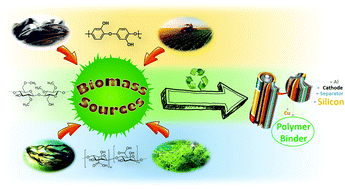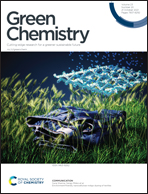Biomass-derived polymeric binders in silicon anodes for battery energy storage applications
Abstract
The demand for portable electronic devices has increased rapidly during the past decade, and has driven a concordant growth in battery production. Since their development as a commercial energy storage solution in the 1990s, lithium-ion batteries (LIBs) have attracted significant attention in both science and industry due to their long cycle life, high energy density, low self-discharge rate, and high working voltage. Production of LIBs requires large amounts of a polymeric binder – commonly polyvinylidene difluoride (PVDF) – for processing and performance purposes. However, since this material is petrochemically-derived, it is far from “green” or sustainable. On the other hand, polymers and their building blocks are found widely throughout nature and can be renewably sourced from biomass at low cost; therefore, replacing PVDF with biomass-derived binders is a promising approach to reduce the environmental footprint of LIBs. Additionally, polymer binders play a critical role in next-generation battery performance. For instance, silicon (Si) is a promising high-capacity anode material for LIBs because of its high theoretical capacity (4200 mA h g−1), low working potential, and high abundance in Earth's crust. However, its huge volume change during charge/discharge tends to result in a shortened cycle life, since conventional binders interact only weakly with silicon's native surface and cannot maintain long-term integrity of the electrode. Naturally derived polymers have found better success in this role due to their high structural advantages. In this review, we summarize recent developments in silicon anode binders derived from various biomass sources, with a focus on polymer properties and their effect on battery performance. We propose various perspectives based on our own assessment of these works, and provide a brief commentary on the future outlook of the field.

- This article is part of the themed collection: Green Chemistry Reviews


 Please wait while we load your content...
Please wait while we load your content...